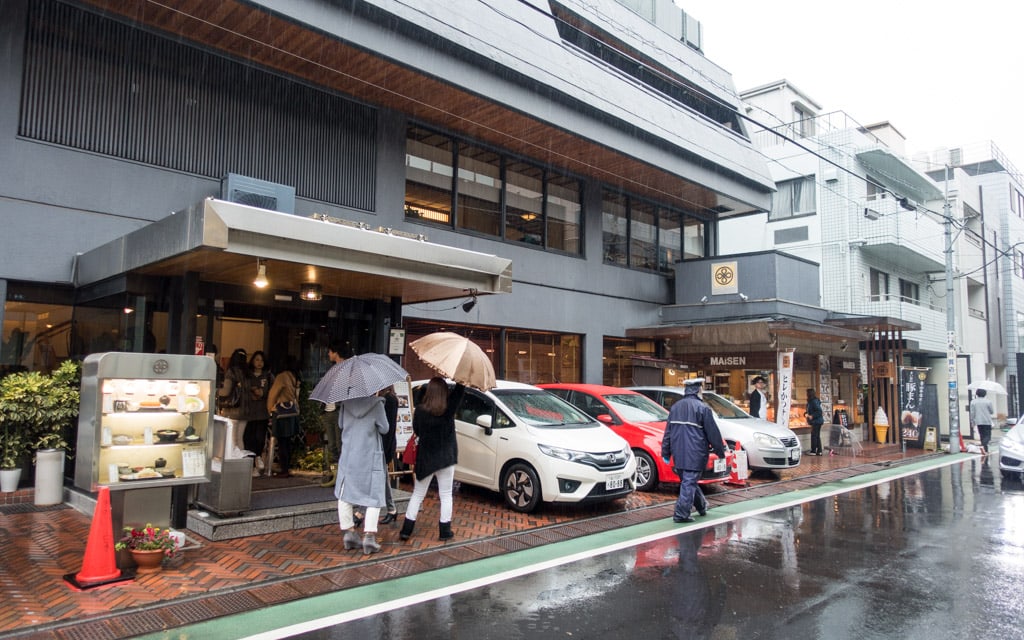
Out of all the foods I have encountered while traveling in Japan, none might be more comforting and delicious than tonkatsu, a Japanese-style pork cutlet which is breaded and deep-fried to perfection. I love tonkatsu, and I never get tired of eating it.
While Tokyo has many great places to try tonkatsu, none might be more delicious than Tonkatsu Maisen Aoyama Honten, near Shibuya Station. Founded in 1965, Maisen now has locations across Japan and a few international locations.
On my recent visit to Tokyo, I stopped by their main store, Tonkatsu Maisen Aoyama Honten. This store, located in the backstreets of Omotesandō, was not far from Shibuya Station and Harajuku.
If you are looking for more information about Tokyo and Japan, I highly recommend you pick up a guidebook such as Lonely Planet Best of Tokyo 2020
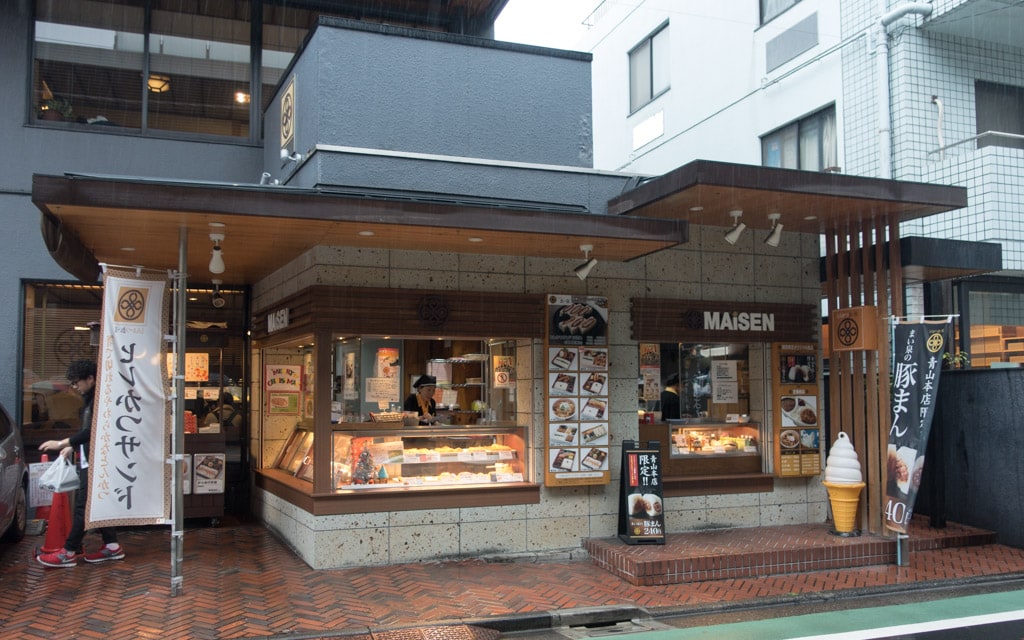
While I could walk right in on my visit and grab a seat at the counter, the wait can often extend out the door during the weekends and busy evenings. If there is a line or you are in a rush, you can visit the outside take-out counter. The counter serves only certain items on the menu.
Table of Contents
Interior of Tonkatsu Maisen Aoyama Honten
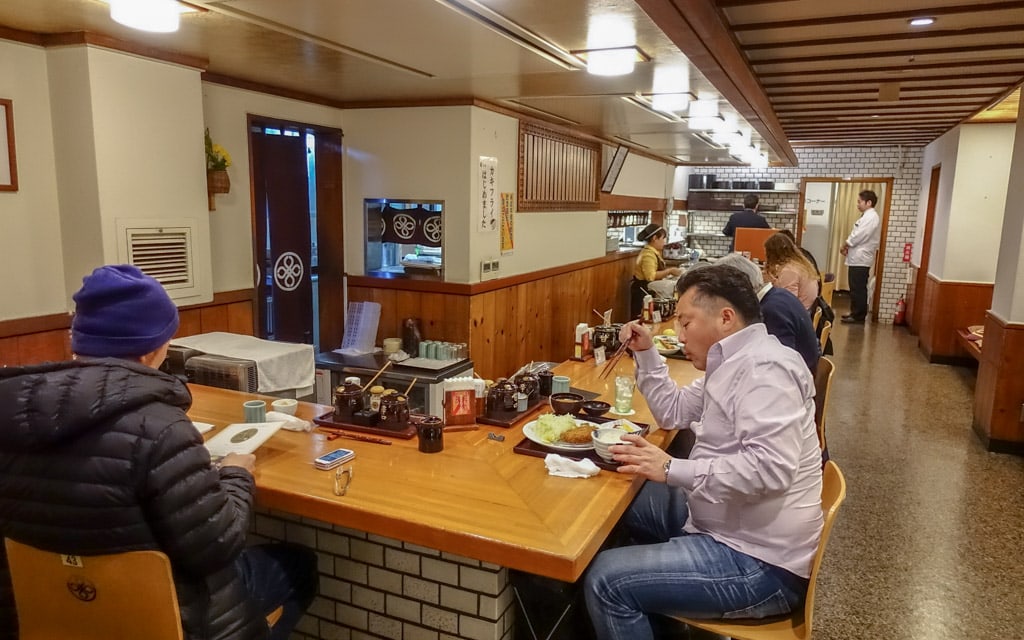
Tonkatsu Maisen Aoyama Honten was a much larger restaurant than met the eye. There were three separate seating areas: a counter, a Japanese-style room, and a central dining room.
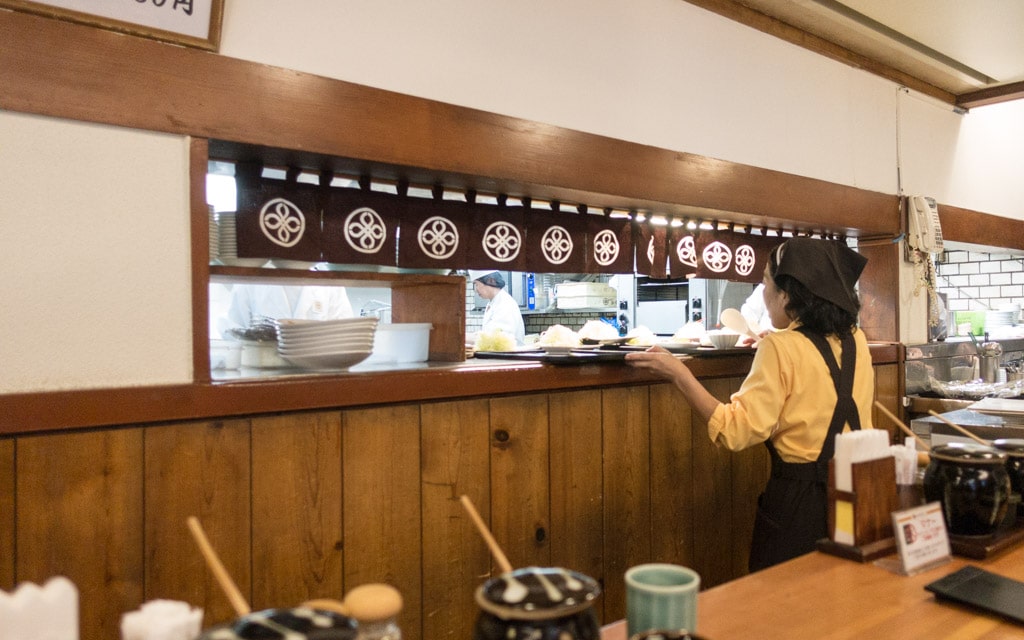
When I walked into the restaurant, on the right hand side was a counter seating area. Most people sitting at the counter were dining alone, including myself.
Sitting at the counter was a more intimate experience than sitting at a table. Sitting here allowed me to peek into the kitchen and better understand the restaurant’s inner workings.
While I didn’t venture upstairs on my visit, there were two dining areas: a Japanese-style room with tatami seating and a much larger open dining room with high ceilings and Western-style tables.
Tonkatsu Maisen Aoyama Honten Menu
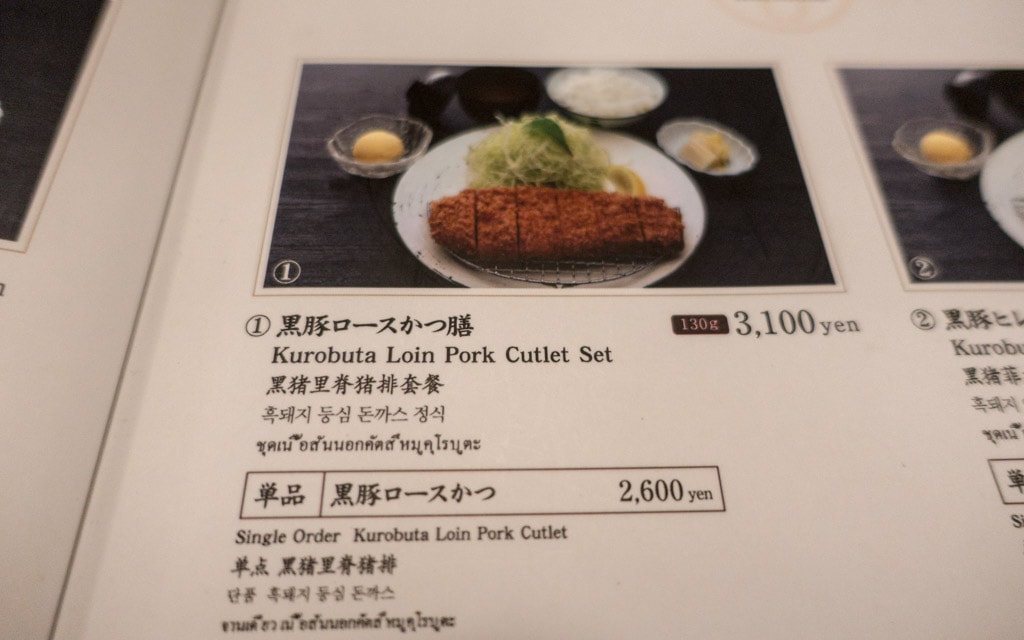
The menu at Tonkatsu Maisen Aoyama Honten was huge. It was so large that I didn’t bother trying to take pictures of it.
The menu had endless choices, many with corresponding photographs. It was like reading a book. The menu explained different breeds of pigs, types of cuts, and everything you need to know about tonkatsu.
There were six different types of cuts on the menu.
Shoulder Loin (A) – A great-tasting cut, complete with just the right amount of fat in the center to complement the meat. It has a rich flavor.
Loin (B) – A fine-tasting cut with just the right amount of fat. Next to fillet cuts, this represents the highest grade of pork. There is great flavor within the fat on the outer side.
Fillet (C) – The highest grade of pork characterized by its fine soft texture. It features minimal fat, resulting in a light, simple, delicious taste.
Arm (D) – A cut with rich flavor and taste resulting from the concentration of porcine muscle.
Pork Belly (E) – Referred to as boned ribs, this cut forms an ideal balance of alternating meat and fat.
Leg Rump (F) – A lean cut with little fat. A soft, fine-tasting meat that is full of vitamin B1.
Consider a few choices if your first choice is unavailable, as many items sold out on my visit.
Roasted Tea and Grated Japanese Radish
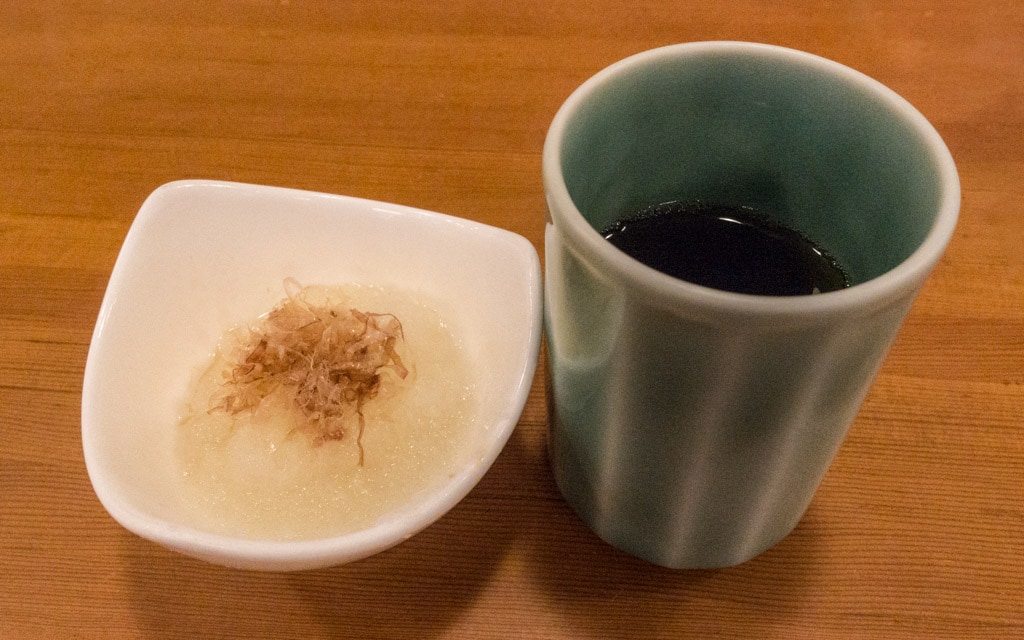
Before my cutlet set arrived, a small bowl filled with Japanese grated radish and roasted tea (houjicha) arrived.
For how simple it was, I was surprised how much I enjoyed the Japanese grated radish topped with bonito shavings. On its own, the radish was fresh, almost watery. The bonito added texture and gave the radish a salty ocean flavor. I poured soy sauce into the bowl over the radish. The soy sauce added a sweet, salty, umami component, which was very satisfying.
The hot roasted tea was just as great, especially on a cold winter night in Tokyo. After roasting, the tea was smoky, slightly bitter, and not too sweet. It was simple but the perfect Japanese tea.
Kurobuta Loin Pork Cutlet Set
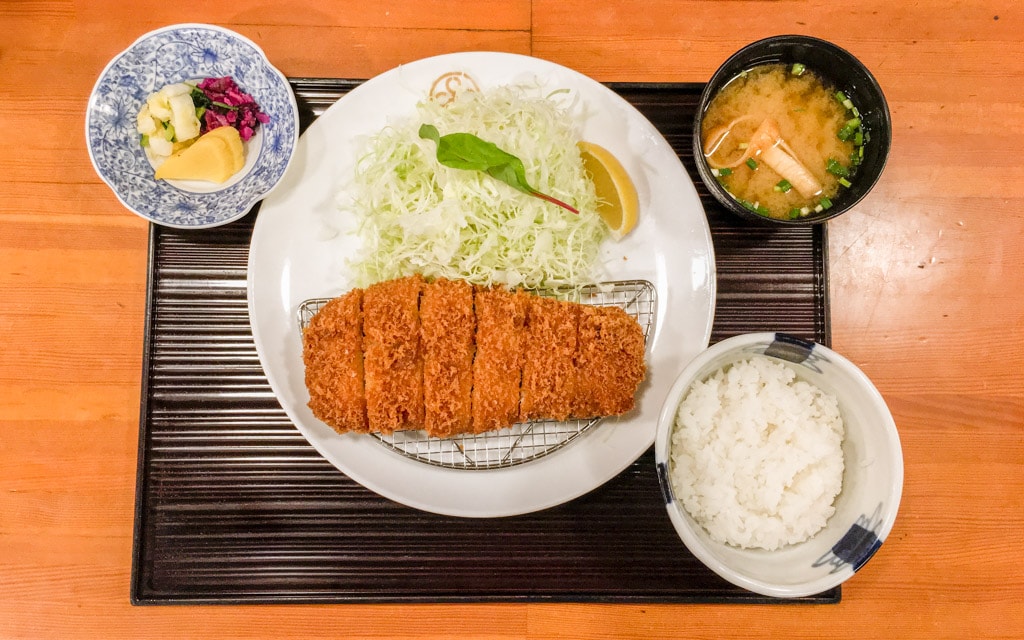
I ordered the Kurobuta Loin Pork Cutlet Set (3100 yen or about $27.81). This signature set consisted of a pork cutlet, sliced cabbage, miso soup, white rice, and pickled vegetables. The sliced cabbage and miso soup were refillable for free on request.
Kurobuta pork, also known as Berkshire pork or Japanese black pork, is a rare breed renowned for its high-fat content and marbling, resulting in a juicy, tender, flavorful meat. The meat was so tender that I could cut it with chopsticks.
Since each pork cutlet was fried to order, it took me a few more minutes than usual to receive my food, but this was fine. I was in no rush and had no problem waiting for my cutlet to be fried fresh.
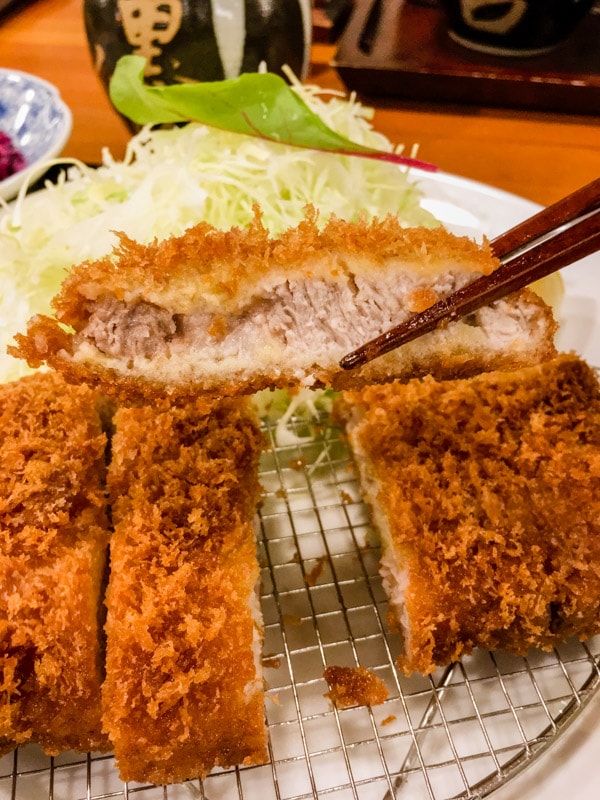
The pork cutlet was fried perfectly by chefs who knew what they were doing. The golden brown crust was beautiful. It was crispy, flaky, rich, and seasoned well without being greasy. It wasn’t too thick or thin, but just the right thickness. The crust remained crunchy and stuck to the pork until the last bite. It was perfection.
Even better was the kurobuta pork loin hidden below the crust. Every piece was juicy and tender. There was not one overcooked or dry piece of pork. I enjoyed the contrast of textures between the crunchy crust and tender, meaty pork.
Often, with pork cutlets, there is too much fat in each piece, resulting in a chewy, stringy texture, but this was not the case. It had the perfect ratio of meaty and fatty bits. And, even better, the fatty parts just melted in my mouth, giving off a rich injection of flavor.
Sides
While simple, the sliced cabbage played a crucial role in the set. Eating tonkatsu on its own can be too rich for some. A few bites of the cabbage helped cut through the richness of the fat.
While I didn’t find this pork cutlet too rich, I enjoyed the contrast of flavors and textures between the pork and sliced cabbage. The sliced cabbage was refillable, so I took advantage of it.
On the side was a simple yet delicious bowl of miso soup. Sometimes, simple is better. The soup, filled with small tender mushrooms, was light, refreshing, and had a well-balanced salty seafood flavor. I could taste the dashi in each sip.
Finishing off the set was a bowl of white rice and pickled vegetables. The vegetables were sweet, salty, and crunchy. Just as with the sliced cabbage, the acidity of the vegetables helped cut through the richness of the pork.
I enjoyed how the salty vegetables added a crunchy bite and a pop of color. Also simple was the white rice. I found myself eating each piece of pork with a little bit of rice.
Dipping Sauces
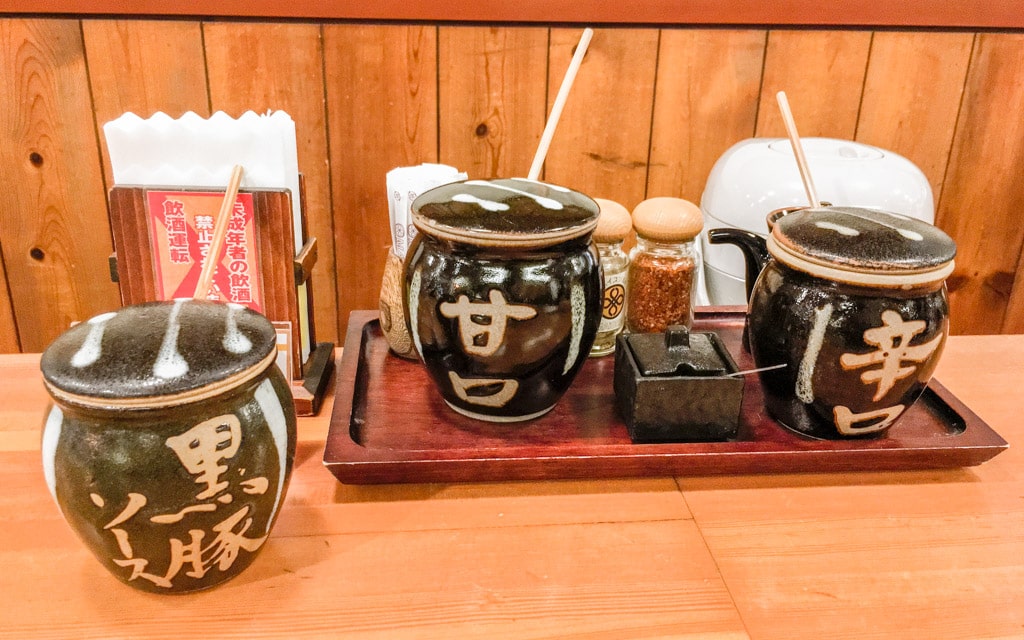
While the pork was great on its own, on the counter and at each table was an assortment of dipping sauces and condiments.
The two main sauces were the Special Tonkatsu Sauce (seen in the middle) and Worcester Sauce (seen on the right). There was also a special sauce (on the left) served only with the Kurobuta sets. The workers recommended not drizzling sauce directly on the tonkatsu but on the side.
The tonkatsu sauce was thick and dense with a sweet, salty, umami taste. The Worcester sauce, while salty, was more tart and sharp in flavor than the tonkatsu sauce. The special sauce was a mixture of both the tonkatsu sauce and Worcester sauce. It was thick and sweet yet acidic. It reminded me of a ponzu sauce with ginger mixed in.
There was also a fantastic spicy mustard. It reminded me of wasabi, with the heat complementing the sweet and salty cutlet sauces.
Service at Tonkatsu Maisen Aoyama Honten
The service at Tonkatsu Maisen Aoyama Honten was not only fantastic but efficient. Even though there was a slight language barrier, the lovely ladies behind the counter constantly checked on me to see if I needed a refill on cabbage, miso soup, or drinks.
Conclusion
Every component of the Kurobuta Loin Pork Cutlet Set was fantastic. The miso soup, pickled vegetables, sliced cabbage, and white rice were delicious and complemented each other. The star of the dish, the fried kurobuta pork culet, was divine. The crunchy crust and the juicy, tender pork cutlet were perfect.
If you are in the Harajuku or Omotesandō area or any part of the city and want the best tonkatsu in Tokyo, I highly recommend Tonkatsu Maisen Aoyama Honten. While not the cheapest tonkatsu in Tokyo, it was well worth the price. It was that good.
Address & Contact
4 Chome-8-5 Jingumae, Shibuya, Tokyo, Japan
GPS Coordinates: 35.667983,139.711531
Hours
Monday - Sunday: 11:00 AM - 10:00 PM
Map
Website
Last Updated on January 20, 2025
Related Posts